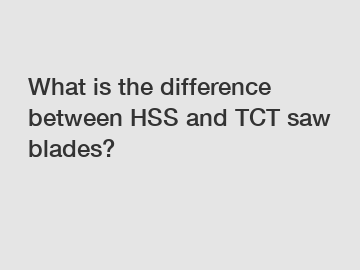What is the difference between HSS and TCT saw blades?
If you want to learn more, please visit our website MASTEK.
What is the difference between HSS and TCT saw blades?
When it comes to cutting tools, there are various types available in the market, each with its unique features and applications. Two popular types of saw blades are the High-Speed Steel (HSS) and the Tungsten Carbide-Tipped (TCT) saw blades. Both have their advantages and are suitable for specific cutting tasks. In this article, we will delve into the differences between HSS and TCT saw blades, the rationale behind their characteristics, and the significance and impact of choosing the right blade for your cutting needs.

HSS saw blades are made from high-speed steel, which is a type of alloy steel enriched with elements like chromium, molybdenum, and vanadium. These blades are known for their excellent heat resistance and toughness. On the other hand, TCT saw blades have teeth made of carbide inserts, which are made from tungsten carbide particles mixed with a metallic binder. The main advantage of TCT blades lies in their exceptional hardness and durability.
The difference between these two types of saw blades boils down to their cutting abilities and lifespan. HSS saw blades are ideal for cutting softer materials such as wood, plastic, and non-ferrous metals. They have a sharp edge and can be sharpened multiple times, which allows for extended usage. However, they may be prone to wear and deformation when cutting harder materials.
In contrast, TCT saw blades are designed for cutting harder materials such as hardwood, laminate, and ferrous metals. The carbide teeth on TCT blades are much stronger and can withstand more heat and friction during the cutting process. Due to their hardness, TCT blades usually remain sharper for a longer time than HSS blades, resulting in improved cutting precision and reduced downtime for blade replacement.
The rationale behind the characteristics of HSS and TCT saw blades lies in the nature of the materials they are intended to cut. HSS blades are more suitable for softer materials due to the toughness and heat resistance of their steel composition. Conversely, TCT blades' exceptional hardness is tailored for cutting through hard materials without losing their sharpness quickly.
Choosing the right saw blade for your cutting needs is essential for optimizing performance and achieving desired results. Using the wrong type of blade can result in poor quality cuts, increased wear on the blade, and wasted resources. With the knowledge of the differences between HSS and TCT blades, users can now make a more informed decision when selecting the appropriate blade for their specific cutting tasks.
In conclusion, the difference between HSS and TCT saw blades lies in their materials, cutting abilities, and lifespan. The choice between the two depends on the type of material being cut and the desired level of precision and durability. Understanding these differences enables users to select the right blade and maximize productivity in various cutting applications. So, whether it's a softer material or a harder one, make an informed decision and ensure the perfect cut for your projects.
Click here to get more.
Contact us to discuss your requirements of 3 Parts Diamond Core Drill Bit. Our experienced sales team can help you identify the options that best suit your needs.



